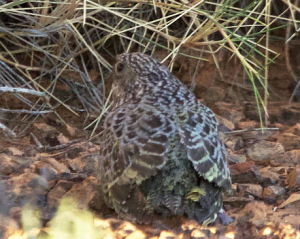Scientists have sighted a fledgling Night Parrot for the first time at Bush Heritage Australia’s Pullen Pullen Reserve in Queensland, confirming the 56,000-hectare nature refuge is successfully protecting a breeding population of one of the world’s rarest birds.
A young fledgling appeared from a hummock of spinifex in the late afternoon, and University of Queensland scientists Nick Leseberg and James Watson were able to photograph and observe the fledgling from a safe distance.

“It was amazing, and we are privileged because this is the first Night Parrot fledgling that has been seen or recorded in nearly 100 years,†said PhD candidate Nick Leseberg.
The fledgling was observed at Pullen Pullen as part of Bush Heritage Australia’s ongoing Night Parrot research and recovery program that is building new knowledge about the rare, rediscovered bird.
Over three years, researchers led by Australia’s foremost Night Parrot expert, Dr Steve Murphy, have spent more than 250 days in the field at Pullen Pullen.
They have carried out the world’s first GPS-tracking of the nocturnal birds, installed 60 song meters (sound recorders) in the landscape, and collected a staggering 20 years of recordings that contain more than 5,000 Night Parrot calls.
“We’ve taken a great leap forward in understanding that the birds use a range of habitats beyond spinifex…we now know they don’t just rely on plants for their water needs and are more vulnerable than we first thought to predation from feral cats along creek lines,†said Dr Murphy.
The next steps in the research program at Pullen Pullen involve further study into what plant species Night Parrots feed on and what habitats they use seasonally over the year; investigation of their breeding biology, including nesting success rates and how climate and landscape conditions affect nesting; and what impact climate change may have on Night Parrot survival.
This ongoing research will be supported by the University of Queensland, Bush Heritage Australia and the Australian Government’s National Environmental Science Programme through the Threatened Species Recovery Hub.
